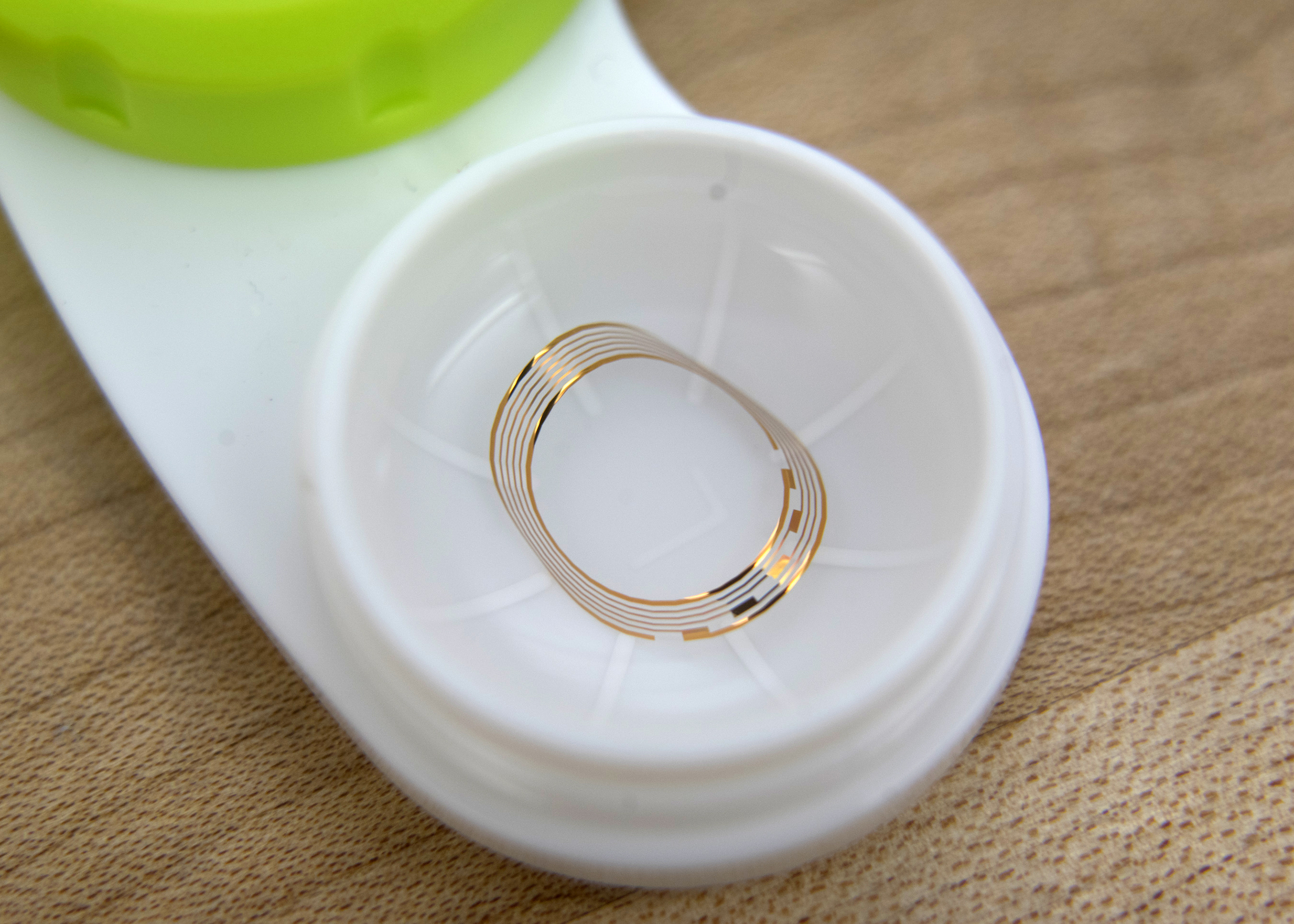
An off-the-shelf contact lens with a gold trace and a specially equipped pair of glasses could provide a non-invasive, personalized therapy to treat and prevent elevated intra-ocular pressure in patients with glaucoma. The technology is being developed by Bionode LLC, a Purdue-related startup co-founded by Purdue professor Pedro Irazoqui and Murray I. Firestone. (Purdue Research Foundation/Vince Walter image)
Glaucoma is the second-leading cause of blindness in the world, according to Glaucoma Research Foundation.
It can cause a buildup in intraocular pressure, which makes the eye secrete too much fluid or prevent the appendage from being able to properly drain that fluid.
This makes pressure build up in the eye, damaging the optic nerve over time and eventually causing blindness.
Current therapies prescribed for glaucoma can vary between eye drops and pills, but factors like ensuring regular usage and possible side effects can impair their effectiveness, according to the National Eye Institute.
A startup affiliated with Purdue University called Bionode may have a solution for this problem.
The venture is founded by Pedro Irazoqui and Murray Firestone. Irazoqui is the Director of the Center for Implantable Devices at Purdue University and serves as Bionode’s Chief Technology Officer while Firestone, an experienced healthcare investor, is the C.E.O.
BioNode owns a portfolio of neuromodulation technologies, but its first effort has created a non-invasive device showing promise in safely treating glaucoma.
The device features an enhanced pair of glasses and a standard contact lens that is imbued with a gold trace, designed to relieve elevated intra-ocular pressure in glaucoma patients. Early tests in mice showed promise and Irazoqui and Firestone are currently putting a clinical trial together of 100 patients to verify the prototype’s efficacy and durability profile.
In an interview with R&D Magazine, Firestone and Irazoqui discussed their technology and where they see the field of electroceuticals going.
R&D Magazine: How did this project come together?
Pedro: The idea for the project started four years ago. I was at the Jackson Laboratory in Bar Harbor, Maine where I had a long-standing collaboration with Simon John, a scientist at the Lab, and was joined by another longstanding colleague, Gabriel Simon, an ophthalmologist from Barcelona.
The three of us were sitting discussing science a number of projects in my lab exploring electroceuticals, and we felt these technologies could create a non-invasive method for treating glaucoma with same or better results as drugs without any side effects.
R&D Magazine: Please discuss how the prototype works. What was the significance of incorporating a contact lens with a trace of gold into the prototype?
Pedro: Basically, this device is similar to a normal pair of glasses. We modified them to contain a coil to produce a magnetic field to generate a current where it hits the eye to make the pressure in the eye drop. For many patients, this is sufficient, for some adding a contact lens with an additional coil focuses the therapy and enhances its effect.
Murray: Adding the gold into the lens helped concentrate the magnetic field, helping us gain the right precision for delivery. There may be other ways to do that as it evolves but we’d like to simplify it as we move on in the design process.
R&D Magazine: Why was glaucoma the first condition you wanted to tackle?
Murray: Much of the initial technologies we worked on targeted epilepsy, but the decision to focus on glaucoma came once we discovered these technologies worked in a non-invasive configuration on the eye, and because of that, this field of use was closer to commercialization than other developments we had in the pipeline.
Plus, the data from early tests with mice were so exciting because the therapy led to a dramatic drop in intra-ocular pressure.
R&D Magazine: How does this device differ from other medical devices currently on the market?
Pedro: It depends on how you define device. There are devices from other companies that operate like a stent and keep the drainage structures open in the eye, but these work for a finite period before becoming occluded.
Our approach is unique because the Bionode is the only device that works in tandem with biological processes. The technology uses electrical signals to work with the body to restore and control physiological production and drainage of fluid into and out of the anterior chamber of the eye. Our device regulates intra-ocular pressure naturally.
Murray: Moreover, as far as we know our therapy does not change tissues and there are no permanent effects.
R&D Magazine: What do you hope to accomplish with your first clinical trial? What type of patients do you hope to enroll?
Pedro: In general, we hope to validate the safety and efficacy profile of the Bionode as well as optimize the therapeutic stimulus parameters.\
Murray: In a perfect world, the patients we would work with would have no prior treatments, newly diagnosed with glaucoma, and elevated intra-ocular pressure. Those patients would be ideal for validation of efficacy.
R&D Magazine: What are your predictions for the electroceuticals space?\
Murray: The best bellwether for electroceuticals is that pharmaceutical firms are investing in their development. This form of medicine could revolutionize healthcare because it can take control of biological functions without the addition of new drugs or side effects. Electroceuticals could become the ultimate choice in personalized medicine.




